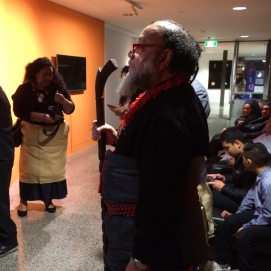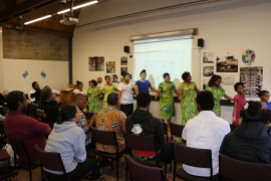Speaking from the Source
I’m currently at Heritage Deferred? Colonialism’s Past and Present, an international symposium delivered by the Goethe-Institut and Stiftung Preussischer Kulturbesitz at Staatliche Museen zu Berlin. I spoke this evening on a panel alongside the excellent Chika Okeke-Agulu and Barbara Plankensteiner in response to a wonderful provocation by Okwui Enwezor.
I took the opportunity to respond to the symposium’s theme by speaking about the Fijian female tattoo revival in a way that felt comfortably right in this setting. Here’s what I delivered:
Ni sa bula vinaka. Thank you for this opportunity to be here.
My name is Ema Tavola; I am a curator and work in the spaces between Museums and academia, audiences and artists. I usually find myself in the position of being a mediator between communities of expectation. This territory can be rough terrain.
I don’t arrive at this event with a doctorate or much internal experience from the museum world. But I want to share a story, from the source. To use my time to talk story, to talanoa – our indigenous format of dialogue.
I have dreamt about tattoos since I was a child and when I was 18, I started tattooing my body. I used to be a bit embarrassed about my first tattoo, but it was the end of the 1990s and it was in the small of my back. I was living in between Fiji and New Zealand, and New Zealand’s cultural renaissance had inspired a boom in the culture and discourse around indigenous tattoo.
Fiji’s tattoo culture was something I first encountered at Fiji Museum. Like much of the Museum’s content, objects and displays represented the past; things disconnected from our modern day realities. The description of heavily inked loins, markings on the face and arms, back and chest, all sounded otherworldly. There was no photographic evidence, and illustrations of two young girls in short liku (skirts) with marked skin, almost felt fictional. Tattoo wasn’t something that was part of my upbringing as a Fijian.
Moving to New Zealand, my mother’s motherland, to pursue tertiary education in the early 2000s removed me from my known context, and my body of tattoos continued to grow. At first, I committed to the discipline of just one tattoo a year. During art school I uncovered more information about Fiji’s tattoo practice, and as my feminism started to take form in my writing and art, the Fijian practice of female tattooing continued to fascinate me.
I remember reading an article in the Journal of Fashion Theory during those art school years, about how a tattoo is what sits between me and you; a deeply political act particularly when worn on subjugated bodies. As a mixed race, diasporically disjointed Fijian living in Auckland, perched on the edge of the Pacific Ocean, tattooing my skin became a powerful language to define my own body, my position and what sustained and supported my identity; a way for me to control the conversation.
Until I met Julia Mage’au Gray, I had only been tattooed by men. Gray is a Papua New Guinean-Australian tattoo practitioner from Mekeo, Central Province. She started tattooing after making a documentary about tattoo in Mekeo; the project became a research journey which took her across the Pacific, talking tattoo to wearers, makers, historians and commentators. I was interviewed by Julia in 2012 for her documentary, Tep Tok, and she started tattooing me in 2014.
As Melanesian women, the conversations with Julia about the feminine nature of tattoo culture across our region, started to breathe life into my curiosity about Fijian female tattoo. In 2015/16, I co-curated The Veiqia Project with Fijian archaeologist Dr Tarisi Vunidilo, leading a creative research process with five Fijian women artists using archives, collections and collective learning to inspire a body of new work for an exhibition.
That project started a conversation in Fiji about our historical female tattoo practice. The exhibition project was delivered in New Zealand, and the artists involved all live in diaspora. Whilst the second iteration of the project returned to Fiji Museum, the nature of exhibition creation and arts appreciation in New Zealand and Fiji are not underpinned by mutually transferable value systems. Museums and galleries still serve a ‘community of taste’ and whilst social inclusion and audience diversification is a hot topic, these spaces are still not accessible, safe spaces for the majority of Fijian and wider Pacific Islander audiences.
Instead of continuing my association with The Veiqia Project, I continued working with Julia, talking about how to wake up the practice of female tattooing amongst Fijian women. It wasn’t through art exhibitions, workshops in art centres, or papers at symposia; it was in practice. Talking about our marks, wearing our marks, talking to people about our marks; this is what revival looks like. It was happening slowly as Julia was approached again and again by Fijian women keen to be marked in Julia’s special visual vocabulary informed by the tattoo practices that link Fiji to the Melanesian world. Social media’s ability to enable connections and storytelling across the world has been critical in our revival.
After starting the process of being marked myself, first on the back, on the arms and thigh, I took the step of marking my face in 2017. Having decided to reverse migrate from New Zealand to Fiji at the end of that year, Julia suggested to me that it was time to finish the set and tattoo my loins. I had never considered going all the way, because the nature of working with a male tattooist on such intimate areas would have broken too many taboos.
With so little visual and descriptive evidence of Fijian tattoo practice, and having been deemed so thoroughly heathen by early missionaries, the idea of our indigenous practice had just about disappeared from cultural memory. This year, Julia tattooed my loins and I shared the process with filmmaker, Lisa Taouma for her documentary, Marks of Mana. I shared and continue to share photographs of the process and the finished work, because our revival will not happen if information is gate kept. My body is clothed in the marks that connect me to not only a process of cultural revival, but to an act of conscious decolonisation, in body and mind.
The largest collection of Fijian tattoo tools sits at the Museum of Archaeology and Anthropology at the University Cambridge in the UK. Earlier this month I visited them with Julia. We made arrangements with Dr Karen Jacobs, and the Museum welcomed us in the way that British people do. We accepted that at no point did they ask about who we were, where we were from or why we were there. We accepted that we were simply ‘source community’ people, interested in things from our past.
I was overcome with emotion seeing our tools. I have been involved in the dialogue about tattooing our bodies as Melanesian women for most of my adult life. Whilst I’ve seen similar tools at Auckland Museum and Fiji Museum, seeing these tools, so far from home, lonely, cold, I was filled with sadness and anger.
Our tattoo practices have been rendered invisible through the process of colonisation. When missionaries told our women to cover their skin, our bodies became invisible, neglectfully excluded from the written histories of our existence. Gradually, women stopped marking their bodies. The generational impact of this erasure is that the cultural memory of our tattoo practice has almost entirely disappeared.
Our revival of Fijian tattoo is now dependent on practice. Through Julia Mage’au Gray’s tattoo work, Fijian women are waking up the memories of our bodies. Marking our skin is the act of reinscribing the importance of our bodies, a sovereignty that colonialism erased.
Without cultural memory, the tools of our practice become tangible anchors; they have such incredible value to us as Fijian women, and in my humble opinion, should be returned to us.
Repatriation is not something I have much scholarly knowledge of. But I wanted to share this experience, as a necessarily autoethnographic insight. It is expensive and emotionally taxing to visit our cultural heritage in colonial institutions. It is offensive that the social protocols around our objects are still determined by colonial norms.
Empowering women and girls, empowers communities. Learning about a practice that was dominated by women – only women marked, and only women and girls wore the marks – has transformative implications. The process is a healing, decolonising act.
Colonial institutions have done their job. To some extent, those early accounts, despite being at times troubling to read, are what has aided the recovery of our indigenous knowledge. For this, there is gratitude. But the process now is to remove the barriers, and enable indigenous communities to benefit from the cultural heritage which has been borrowed from them.

Tomorrow I’m speaking on a panel entitled, Materialities, Colonial and Post-Colonial Narratives alongside Richard Drayton (Rhodes Professor of Imperial History, King’s College, London, UK), Nydia Gutierrez (Chief Curator, Museo de Antioquia, Medellin, Colombia), Chika Okeke-Agulu (Professor of African and African Diaspora Art, Princeton University, Princeton, USA), moderated by Eva Bentcheva (Goethe-Institut Fellow at Haus der Kunst, Munich).
I’m live tweeting from this event too – tune in @colourmefiji






















































